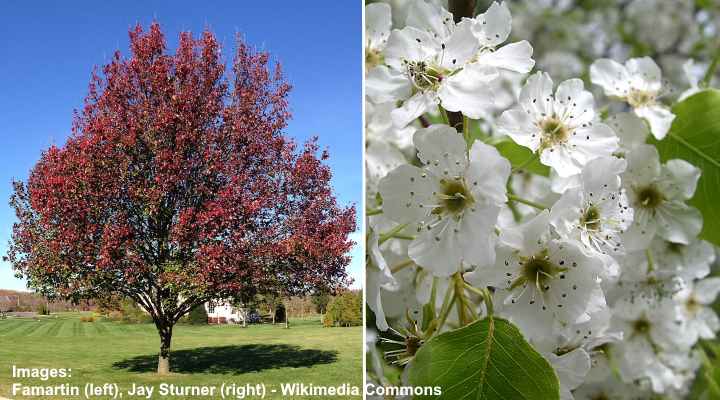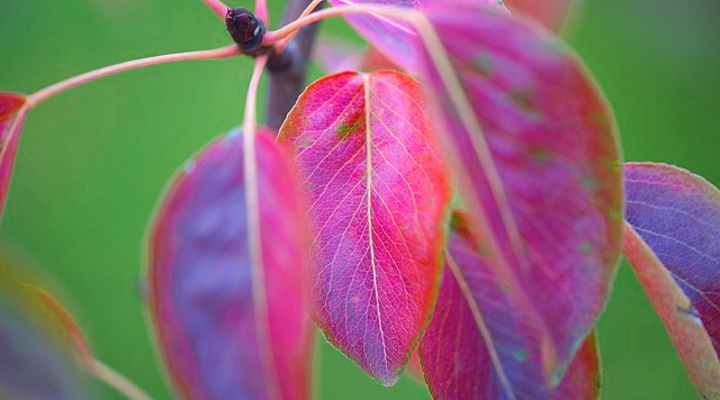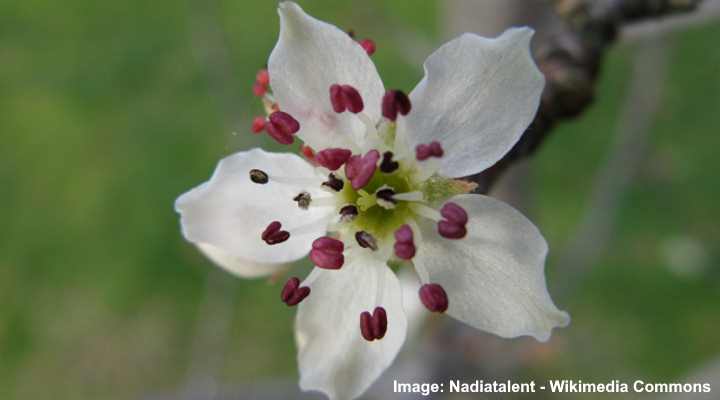Types of Ornamental Flowering Pear Trees – Fruitless Pear Trees (Pictures)

The ornamental flowering pear tree (Pyrus calleryana) blossoms with spectacular white flowers every spring. The small deciduous pear tree species has a rounded shape, oval, glossy green leaves, and five-petaled white flowers. Apart from the landscaping tree’s beautiful flowers, ornamental pear trees have striking yellow, orange and red fall colors.
The most common ornamental pear tree is the Callery pear and is sometimes called ornate fruitless pear tree. Although all flowering pear trees—including Pyrus calleryana—actually produce fruit, the tiny pears on ornamental pear trees are too insignificant to be useful. However, what this pear tree species lacks in fruit makes up for in spring with its masses of white blossoms covering the bare branches.
This article is a complete guide to identifying the many types of ornamental pear trees. Descriptions and pictures of flowering pear trees will help you choose the best one for your backyard. You will also find out how to care for ornamental flowering pear trees in your yard.
Ornamental vs. Fruiting Pear Trees

A close up picture of ornamental pear fruit
The difference between fruiting pear trees and ornamental Callery pear trees is their fruit. Although ornamental pear trees fruit, the pears are exceedingly small, measuring only about half an inch (1 cm). Pyrus calleryana fruit also tastes bitter, and, for most people, the small pears are inedible.
The fruit on Callery pear trees such as the ‘Bradford’ cultivar grows in small clusters like cherries. Unlike the fruit from regular fruiting pear trees, Callery pears are round like berries. Usually, the clusters of small round pears attract birds and wildlife in fall and winter.
Ornamental Flowering Pear Trees

Ornamental pear trees flower with beautiful white flowers every spring. In the picture: Bradford ornamental pear tree in bloom
Ornamental pear trees are deciduous flowering trees with shiny green leaves, cup-shaped white flowers, and beautiful fall colors. Most varieties of Pyrus calleryana have a pyramidal, upward growth shape. Ornamental pear trees grow between 32 and 40 ft. (10 – 12 m) tall and around 22 to 30 ft. (7 – 9 m) wide.
Callery pear cultivars are generally easy to care for landscaping trees. Unlike fruiting pear trees, Pyrus calleryana isn’t a messy tree that drops a lot of fruit. Additionally, ornamental pear varieties are heat and drought-tolerant and are resistant to many fruit tree diseases. These facts make ornamental pear trees popular for front and backyards.
Ornamental flowering pear trees grow in USDA zones 5 through 9.
Types of Ornamental Pear Trees
Most varieties of ornamental pear trees are cultivars of the flowering tree species Pyrus calleryana. However, other types of fruit trees such as Manchurian pear (Pear ussuriensis), snow pear (Pyrus nivalis), and the weeping pear tree (Pyrus salicifolia) are also grown for their blossoms, not fruit.
Here are some of the most attractive ornamental pear tree cultivars to plant in your garden landscape:
- Bradford Pear (Pyrus calleryana ‘Bradford’)—A popular ornamental pear tree with conical shape, white pear blossoms, and glossy green, ovate leaves that turn shades of orange, purple, yellow, and red in the fall.
- Cleveland Select (Pyrus calleryana ‘Cleveland Select’)—Showy white flowers and a narrow growth helps identify this ornamental pear cultivar.
- Capital Pear (Pyrus calleryana ‘Capital’)—A narrow vase-shaped crown and masses of white flowers are the identifying features of the ‘Capital’ pear cultivar.
- Redspire Pear (Pyrus calleryana ‘Redspire’)—A hardy ornamental pear with glossy, green foliage, pyramid shape, and an abundance of white spring flower clusters.
Pear Tree Blossoms

Ornamental pear flowers
Pyrus calleryana flowers have five white petals that are slightly cup-shaped. The ornamental pear blossoms grow in clusters of five to seven flowers. A distinguishing feature of many ornamental pear trees is that they give off an unpleasant aroma.
How to Care for Flowering Ornamental Pear Trees
Care for ornamental flowering pear trees by growing them in a sunny location and planting them in well-draining soil. Water Pyrus calleryana once a week during hot weather to keep the soil moist but not soggy. Pruning is not necessary to keep their shape, but you can remove dead branches in winter.
Ornamental Flowering Pear Trees (With Pictures)
Let’s look in detail at the various varieties of flowering ornamental pear trees you can grow in your backyard.
Callery Pear (Pyrus calleryana)

Flowering ornamental Callery pear
Callery pear is a deciduous fruitless flowering pear tree with clusters of dainty white flowers. Pyrus calleryana has glossy dark green foliage growing in a pyramid shape. The leaves turn brilliant hues of red, purple, bronze, and yellow in fall. Callery pear grows between 16 and 35 ft. (5 – 10.5 m) tall and 16 ft. (5 m) wide.
The Callery ornamental pear tree has a conical shape that becomes rounded as the tree matures. The fast-growing tree grows best in full sun and adapts well to most soil conditions. You can plant a Callery pear as a specimen landscaping tree for its spring colors, lush summer foliage, and brilliant fall colors.
As with growing most ornamental pear trees, the Callery pear thrives in USDA zones 5 through 8.
Ornamental Pear Tree ‘Cleveland Select’ (Pyrus calleryana ‘Cleveland Select’)

Ornamental Pear Tree ‘Cleveland Select’ (Pyrus calleryana ‘Cleveland Select’)
The ‘Cleveland Select’ pear tree produces pretty white flowers every spring. The attractive features of Pyrus calleryana ‘Cleveland Select’ is its narrow pyramidal form, early spring flowers, and glossy green, ovate leaves with wavy edges. ‘Cleveland Select’ leaves turn beautiful shades of purple, red, and orange in the fall.
The ‘Cleveland Select’ grows up to 35 ft. (10.5 m) tall and 16 ft. (5 m) wide. The ornamental fruitless pear tree has strong branches, upward growth, and an attractive cone-like shape. The fast-growing ornamental pear thrives in USDA zones 4 through 9, making it one of the hardiest flowering trees.
Grow the ‘Cleveland Select’ pear in full sun and well-draining, rich loamy soil. As with most ornamental pear tree care, water the tree regularly in spring and summer to keep the ground moist. Add a layer of organic mulch over the root zone to keep the soil moist and add nutrients.
Ornamental Pear ‘Bradford’ (Pyrus calleryana ‘Bradford’)

Ornamental Bradford pear tree in autumn (left) and flowers (right)
The ‘Bradford’ ornamental tree cultivar blooms every April with masses of decorative white flowers growing in large clusters. ‘Bradford’ pear trees have narrow-oval dark green leaves with a shiny surface and wavy margin. The ornamental pear tree’s foliage turns shades of red, purple, and bronze in the fall.
‘Bradford’ is a thornless pear cultivar, growing between 30 and 50 ft. (9 – 15 m) tall and up to 35 ft. (10.5 m) wide. As the attractive landscape tree matures, the spreading crown takes on a rounded shape, making this an excellent shade tree.
An issue with growing the ‘Bradford’ pear flowering tree is its branch strength. The tree’s branches tend to break easily in strong winds. Once a popular tree for garden landscapes, gardeners don’t recommend planting ‘Bradford’ as an ornamental flowering pear tree.
‘Autumn Blaze’ Ornamental Pear Tree (Pyrus calleryana ‘Autumn Blaze’)

Autumn foliage of Pyrus calleryana ‘Autumn Blaze’
The ‘Autumn Blaze’ is a non-fruit bearing pear tree with showy white flowers and spectacular warm fall colors. ‘Autumn Blaze’ deciduous pear trees grow up to 40 ft. (12 m) tall with a spread of 30 ft. (9 m). The shiny dark green leafy foliage grows in a rounded shape on a single slender trunk.
‘Autumn Blaze’ burst into glorious white colors in early spring when the tree blooms. In fall, when the leaves change color, the pear tree’s color transforms from glossy dark green into brilliant bright red.
As a cold-hardy, fast-growing pear tree, ‘Autumn Blaze’ is tolerant of temperatures as low as -30°F (-34°C). This Pyrus calleryana cultivar thrives in USDA zones 4 through 9.
‘Redspire’ Pear Tree (Pyrus calleryana ‘Redspire’)

Blossoms of ‘Redspire’ pear tree
The ‘Redspire’ Pyrus calleryana cultivar is a pear tree that has no fruit worth eating. ‘Redspire’ ornamental pear’s attractive features are its large white, showy blossoms, and red or yellow fall foliage. ‘Redspire’ pears grow up to 40 ft. (12 m) tall and 20 ft. (6 m) wide.
Pyrus calleryana ‘Redspire’ flowering pear trees have an upright, spreading growth habit and columnar shape. The branches produce ovate-shaped leaves between 2” and 4” (5 – 10 cm) long. From all the ornamental pear trees, ‘Redspire’ has some of the largest blossoms.
Although classed as a fruitless ornamental pear tree, ‘Redspire’ produces tiny round pea-sized pears. The clusters of brown or tan berry-like fruits attract birds and other wildlife. Unlike fruiting pear trees, the ‘Redspire’ isn’t a messy tree, and its small fruits don’t drop.
‘Aristocrat’ Pyrus calleryana

‘Aristocrat’ pear tree is relatively slow growing compared to other ornamental pear trees
‘Aristocrat’ is a white-flowering pear tree with an oval-pyramidal crown, narrow shiny dark green leaves, and small inedible fruits. Like most ornamental pear trees, ‘Aristocrat’ is a thornless flowering tree. The pear tree grows between 25 and 35 ft. (7.5 – 10.5 m) tall and up to 25 ft. (7.5 m) wide.
A unique feature of ‘Aristocrat’ ornamental pear is its horizontal branching. Compared to other pear tree cultivars, the ‘Aristocrat’ is a slow-growing tree. However, it has a typical pyramidal shape, common to most ornamental flowering pear trees.
Pyrus calleryana ‘Aristocrat’ grows best as a shade tree in garden landscapes. You can also grow this pear tree as a tall screen plant if you plant them in rows. This adaptable flowering tree also grows well in shallow ground or compact spaces.
‘Chanticleer’ Pyrus calleryana

Young ‘Chanticleer’ ornamental pear tree (left), leaves and flowers (right)
The ‘Chanticleer’ ornamental pear tree has a slender pyramidal shape, brilliant white flowers, and leathery, dark green leaves that dangle on the end of long petioles. ‘Chanticleer’ grows around 30 ft. (9 m) tall, and its dense foliage spreads up to 15 ft. (4.5 m) wide. Some varieties of the tree have a columnar growth habit.
‘Chanticleer’ is one of the best ornamental pear trees for garden landscapes. Due to its slender growth habit, ‘Chanticleer’ is ideal for narrow spaces. The attractive upright trees grow in most types of soil and are tolerant of drought. The only care the pear tree needs is at least six hours of sunshine and regular watering during hot weather.
Apart from its white spring flowers, the tree’s beauty comes from the dense, lush foliage that turns into rich orange and red fall colors.
‘Korean Sun’ Pear Tree (Pyrus fauriei)

The small Korean Sun ornamental pear tree has attractive foliage colors in fall
The Korean Sun pear tree is a dwarf ornamental pear with masses of stunning white spring flowers and lush, dense, glossy green foliage. The oval leaves on the Korean Sun pear appear just before the flower buds open. The spreading pyramidal foliage turns spectacular red and orange tones in the fall. The slow-growing, compact small flowering tree grows up to 15 ft. (4.5).
The attractive features of the decorative Korean Sun pear tree are their dense flower clusters and brilliant red fall colors. Unlike other ornamental pear trees, the Korean Sun tree’s blossoms have only a light, not offensive pungent aroma.
The Korean Sun pear is an ideal ornamental flowering tree for small, compact gardens. The low-maintenance tree requires little pruning to keep its appealing pyramid shape.
‘Capital’ Pear (Pyrus calleryana ‘Capital’)

‘Capital’ flowering pear tree has slender growth which makes it suitable for narrow spaces
The ‘Capital Pear’ ornamental pear is a thornless flowering tree with narrow growth and a vase-shaped crown. Like all fruitless pear trees, the ‘Capital’ pear cultivar produces spectacular flowers growing in dense clusters. The upright, lush foliage is made from glossy, dark green, ovate leaves.
Pyrus calleryana ‘Capital’ grows up to 36 ft. (11 m) and is between 8 and 12 ft. (2.4 – 3.6 m) wide. You can plant this decorative pear tree in a sunny location in your garden. To encourage masses of blooms, keep the plant well-watered in spring and summer. ‘Capital’ pear’s slender growth makes it perfect for narrow places in your garden.
Weeping Pear Tree (Pyrus salicifolia ‘Pendula’)

Weeping pear tree (left) with silvery gray-green narrow leaves and flowers (right)
The weeping pear is a small ornamental pear tree with a rounded crown, drooping branches, clusters of large white flowers, and willow-like leaves. The Pyrus salicifolia ‘Pendula’ produces inedible fruits that are hard and bitter. The pendulous pear tree grows around 20 ft. (7 m) and is 20 ft. (7 m) wide.
Also called the willow-leaved pear due to the shape of its green leaves, the elegant weeping pear has arching branches. The rounded canopy and drooping foliage give the specimen tree an umbrella shape. This small landscape tree is also called the weeping silver-leaved pear because of its gray-white silvery foliage.
Care for this ornamental weeping pear by ensuring it gets plenty of sunshine and moisture. Pyrus salicifolia ‘Pendula’ grows well in most soils, including infertile sandy soil.
Edgedell Pear (Pyrus calleryana x Pyrus betulaefolia)

Flowers of Edgedell pear tree
The Edgedell ornamental pear is a hybrid flowering tree with silvery-gray leaves, dense clusters of white, star-shaped flowers, and upright growth. The medium-sized growth and narrow, conical shape make the Edgedell pear perfect for small backyards. The Edgedell pear tree grows to around 26 ft. (8 m) and is 13 ft. (4 m) wide.
Like all ornamental pear cultivars, the Edgedell pear has fantastic fall colors. The ovate leaves turn the tree’s foliage shades of bright red, pink, yellow, and sometimes dark purple.
‘Fauer’ Pear Tree (Pyrus calleryana ‘Faueriei’)

‘Fauer’ pear tree blossoms
The ornamental pear tree ‘Fauer’ has snowy-white spring blossoms, dark green, ovate leaves, and fantastic yellow and orange fall colors. ‘Fauer’ pear tree has a rounded crown dense foliage that makes it an excellent shade tree. The Pyrus calleryana ‘Faueriei’ cultivar grows between 30 and 40 ft. (9 – 12 m) tall and is 20 to 30 ft. (6 – 9 m) wide.
‘Fauer’ ornamental flowering pears grow in USDA zones 5 through 8. As with all ornamental trees in the genus Pyrus, the decorative tree should grow in full sun. Compared to other pear trees, the ‘Fauer’ cultivar needs continuously moist soil.
Snow Pear (Pyrus nivalis)

Snow pear flower. The tree has edible tart fruit and is commonly grown for its decorative value
Although snow pear produces 1.2′ – 2′ (3 – 5 cm) edible fruit, the fruit has tart sour-bitter taste and therefore snow pear is usually grown for its ornamental value.
Also known as yellow pear, the low maintenance snow pear is a small to medium size tree with silvery green leaves that show beautiful autumn colors, round growth habit and white flowers in spring.
Pyrus nivalis can grow to 20 – 33 ft. (6 – 10 m) and 16 – 23 ft. (5 – 7 m) wide. Snow pear is a hardy tree that is drought tolerant and adapts well to various temperatures.
Related articles:
